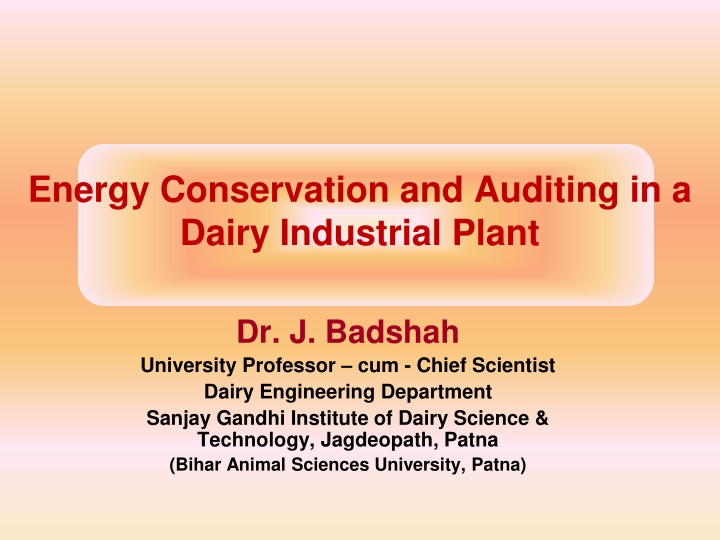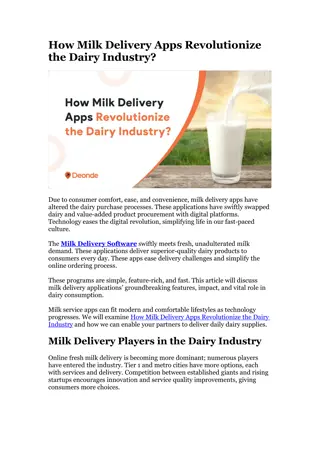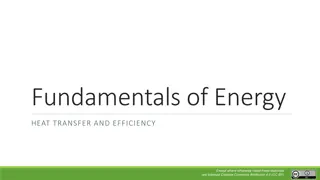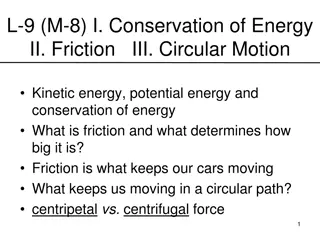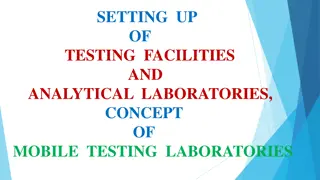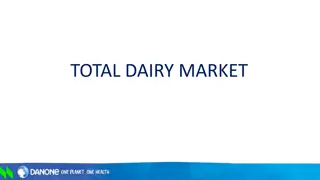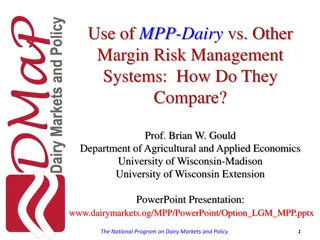Comprehensive Energy Conservation and Auditing in Dairy Industry
Energy conservation, auditing, and efficiency play crucial roles in reducing production costs, improving environmental impact, and ensuring sustainability in dairy industrial plants. Through energy auditing, data is collected, energy losses are identified, and measures are implemented to save costs and enhance efficiency. The methodology involves complex technical assessments, data analysis, and implementation of corrective measures. Phases of energy auditing include data collection, analysis of energy consumption, examination of plant capacities and performances, and recommendations for energy conservation methods.
Download Presentation

Please find below an Image/Link to download the presentation.
The content on the website is provided AS IS for your information and personal use only. It may not be sold, licensed, or shared on other websites without obtaining consent from the author.If you encounter any issues during the download, it is possible that the publisher has removed the file from their server.
You are allowed to download the files provided on this website for personal or commercial use, subject to the condition that they are used lawfully. All files are the property of their respective owners.
The content on the website is provided AS IS for your information and personal use only. It may not be sold, licensed, or shared on other websites without obtaining consent from the author.
E N D
Presentation Transcript
Energy Conservation and Auditing in a Dairy Industrial Plant Dr. J. Badshah University Professor cum - Chief Scientist Dairy Engineering Department Sanjay Gandhi Institute of Dairy Science & Technology, Jagdeopath, Patna (Bihar Animal Sciences University, Patna)
Energy Auditing, Energy Conservation and Energy Efficiency Energy auditing is thorough exercise carried out for energy conservation in different unit operations and utilities required along with estimating the causes of low energy efficiencies and high losses of products and energies. It assists in reduction of production costs and heading the unit to be Green. This is not only important for significantly reducing production costs but also is environmentally friendly. Energy conservation is the activities about saving energy by cutting down the wastage and losses, recycling or proper scheduling of operations. Energy Efficiency differs from energy conservation in the replacement of less energy efficient components or systems to more energy efficient equipments and minor improvements in existing system for enhancing its efficiency.
Objective and Methods of Energy Auditing In energy auditing, Complex technical assessment of present energy consumption of an industrial unit/commercial facility is performed with following objectives: i. Accumulating data at various points ii. Identifying energy losses and critical junctions iii. Enabling energy conservation and cost savings The Methodology used to meet objectives are: i. Analyzing the performance by B.E.E. experts ii. Collating the parameter data with bench mark iii. Manifesting and implementing the corrective measures in all forms of processes, utility equipments and energies ( i.e. electrical, thermal and operational efficiencies). iv. Conducting energy balance, heat & mass balance and specific energy requirement in all unit operations and pumps, compressors etc.
Phases of Energy Auditing As per energy conservation act, 2001, Energy Auditing is defined as verification, monitoring and analysis of use of energy including submission of technical report containing recommendations for improving energy efficiency with cost benefit analysis and action plan to reduce energy consumption. Objectives of energy audit include two phases: Phase I Collection of data on operational parameters, energy consumption through a questionnaire or log books Study of existing plant capacities and their performance Analyzing specific thermal and electrical energy consumption Study of power sources, distribution system, load scheduling for 24 hour period, load factor, power factor, efficiency of large motors, automations etc. Measurement of operational parameters in different plant system, carrying out heat and mass balance, study of limitations and energy losses Check potential for energy conservation methods to be recommended for thermal and electrical energies separately. Produce specific recommendations and measures.
Phases of energy Auditing Preparation of capital cost estimates and establishing techno- economic feasibilities. Formulating tentative time schedule for implementation of the recommendations and measures. Undertaking broad cost benefit analysis in terms of saving in energy consumption per unit of production and pay back period Phase II Follow up with industry on periodic basis to achieve desired energy use efficiencies with the use of (i) Preliminary Energy Audit and (ii) Detailed Energy Audit methodologies. The detailed energy audit offers the most accurate estimate of energy saving and cost by considering interactive effects of all the projects with major equipments employing electrical and thermal energies. The recommended energy conservation and energy efficiency improvement programs become energy solutions for Audit report.
Energy Solutions and Measures for Energy Conservation in dairy plants Milk Procurement and Initial milk quality maintenance: Clean Milk Production and procurement incentives Encouragement for use of BMC (Bulk Milk Cooler) to reduce bacterial load at milk Processing plant It would improve initial quality, reduce energy consumption, reduce pasteurization cost and improve the quality of finished products Milk Processing and Utilities Consumption: Efficient steam generation, distribution and Utilization (based on furnace oil) Efficient Refrigeration generation, distribution and utilization Efficient Compressed Air generation, distribution and uses Conservation of Electrical Energy Efficient Running of Pasteurizers, Manufacturing sections, Packaging sections for products Use of solar energy as partial substitutes to thermal energy Efficient Effluent Treatments and disposal a. b. c. a. b. c. d. e. f. g.
Efficient steam generation, distribution and Utilization Selection of fuel to have Maximum steam output with minimum cost input Periodic Fuel analysis to know available effective Kcal (NCV) and level of impurities Ideal combustion parameters (Co2: 12-13%, O2level: 1-4 %, Excessive air level: 5-20%, Stack temperature: 180-200 C, Max eff.: 80-85%) Feed water Preheating/Combustion air preheating by using flue gases Feed water treatment to less than 5 ppm hardness Adequate insulation of steam line and heat transfer surfaces Proper and periodic blowdown. TDS should not exceed > 3000 ppm Timely correcting the steam leakages Use of dry saturated steam instead of wet steam Periodic and proper air purging Adopt suitable condensate recovery system Use of solar hot water system as per techno economic feasibility Periodic cleaning of water side/fire side is very important to avoid scale formation and soot deposition
Efficient Refrigeration generation, distribution and utilization Proper insulation of chilled water lines, cold storage and IBT Timely and periodic air and oil purging from the system It is advisable to segregate IBT, cold storage and Deep Freeze suction lines and connecting to separate refrigeration compressors The refrigeration effect must be efficiently utilized by elimination of losses of chilled water and heat losses Efficient running of refrigeration compressors Periodic cleaning of evaporators and condensors (0.8 mm scale built up on condensor tubes can increase energy consumption by 30- 35%) Night time running of compressors reduces the peak load and minimum KVA consumption and reduced electric bill Timely preventive maintenance of compressors and systems Minimizing reprocessing load to zero level. Efficient running of cold storage, deep freeze and Icecream sections
Efficient Compressed Air generation, distribution and uses Adequate intake of filtered and cooled air. Adequate cooling of air compressors Avoid leakages Minimum pressur drops in air lines Proper removal moisture from compressed air distribution system Segregation of low and high pressure air requirements Proper and effective maintenance of compressed air generation and distribution system
Conservation of Electrical Energy Maximum demand of electricity should be monitored properly to reduce the electric bill Power factor should be controlled to near unity Use energy efficient motors, equipments, transformers and othe appliances Use of soft starters for heavy duty motors to improve power factor Use of CFL/LED lighting devices Multistage compression in case of high pressure ratio, 9. Selection of refrigerants Eco-friendly Hydrocarbons and hydroflurocarbon (HFCs) are replacing fully halogenated (Badshah, J., 2010), 10. Install variable frequency drive and monitor system performance. (CFCs) Refrigerants
Efficient Running of Pasteurizers, Manufacturing sections, Packaging sections for products Periodic cleaning and maintenance of milk pasteurizers Chilled milk pipe lines and holding section pipe line should be properly insulated Milk pasteurizer temperature must be controlled properly with PID controller and FDV system to produce safe pasteurized milk and to avoid reprocessing Plant regeneration efficiency should be monitored and controlled properly. Old milkpasteurization plant with poor regeneration efficiency, pinholes in plates and poor hygiene should be considered for replacement.
Efficiency Improvement in manufacturing sections Ghee is made in dairy plant from butter or directly from cream. Clarification of butter in ghee kettle requires high amount of steam because butter contains 16 % moisture. Instead of this procedure a large portion of water can be removed by centrifuging the melted butter and then clarifying in the ghee kettle. It can save steam and time and also would improve the capacity of plant. The heat of already clarified ghee can be used to melt the butter. Use of Scraped surface heat exchanger system for forewarming and concentration of milk to prepare small scale and economized condensed milk and indigenous dairy products for energy saving and quality production. Use of Non- thermal technologies such as Membrane technologies in milk processing, High Hydrostatic pressure technology for cold processing, Superfluid extraction technology, Eco friendly packages for dairy products, pulsed electric field technology, Nano technology for nano food and intelligent packaging etc. are the scope for producing qualitative and functional safe foods by optimizing energy consumption (Minz, et. al, 2010).
Efficiency Improvement in Condensing and Drying Plants 5-effects evaporator with TVR: 8 kg water evapn per kg steam 7 effects evaporator with TVR: 10 kg water evapn. Per kg steam Multiple effects evaporator without condenser with MVR: Low steam consumption in comparison to equivalent evaporator with TVR and no cooling water requirement. Use of multipass construction in each effect to retain the advantages of tube wetting rate for different products to make flexible. Higher degree of automation gives higher quality with lower cost. Full automation of spray dryers and feed treatment to control moisture content in the powder and also to control quality of powder including avoiding burnt particle and safety of drying chamber must be provided in the system. This may be done by feed rate regulation through servomotor and positive pumps or by air heater regulation. Three stage dryer efficiency increases by 20 percent from 35 % to 55%. To reduce stack losses, bag filter, cyclone separator and wet scrubbers etc. should be efficiently designed and installed. Their efficiency should be checked regularly.
Use of solar energy as partial substitutes to thermal energy Solar energy can be used for hot water generation for milk pasteurization and CIP To install fully self tracking generation of hot water and storage in a tank to save furnace oil used for boiler Biofuels offer a sustainable and cleaner source of power, with significantly lower green house gas emissions. Biomass (wood waste/agricultural residues etc.) gasifier has high potential for production of low calorific value gas for small scale agro based industries for thermal energy and electricity applications. Solar electric also known as photo voltaic cells that convert sunlight directly into electricity for lighting, battery charging, small motors, water pumping and electric fences etc. parabolic solar concentrator for
Use of efficient Effluent Treatment Plant There is considerable scope of energy conservation, if effluent generation and treatment are given due attention Segregate low BOD and High BOD streams to save energy and land for aeration lagoons in aerobic digestion The combination of anaerobic cum aerobic treatment plants offers huge savings For water recycling and reuse, the concept of tertiary treatment to give good quality water should be adopted Use of Upflow Anaerobic Sludge Blanket (UASB) technology followed by Aerobic treatment saves not only energy consumption and energy cost but also produce bio gas. Methane/bio gas can be used to generate electricity which further reduces the operating and thereby production cost of product. Biomethanation of dairy effluent is an anaerobic treatment process of dairy effluent to remove the organic substances and to convert them into methane rich biogas. The methane content in the biogas is 65%. The reactor can tolerate an organic loading of 10 kg COD/ cubic meter reactor volume / day. Methane rich gas is produced through this process and can be utilized for thermal applications and power generation as well (Rathore, 2010).
